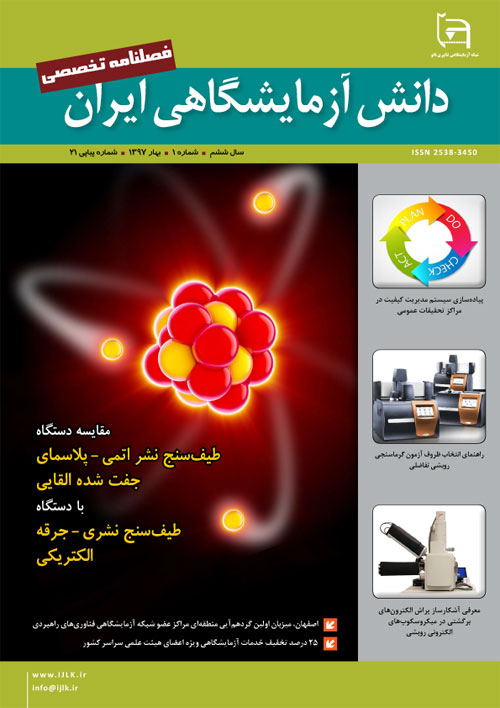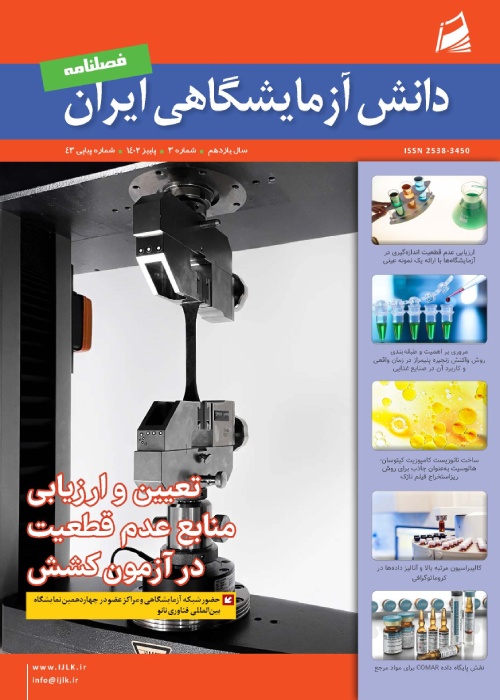فهرست مطالب

مجله دانش آزمایشگاهی ایران
سال ششم شماره 1 (پیاپی 21، بهار 1397)
- 44 صفحه،
- تاریخ انتشار: 1397/03/20
- تعداد عناوین: 6
-
صفحه 2
- استاندارد
- مقالات
-
Page 7
In recent decades, it has become increasingly important for public research centers to attract external clients, including government, private and public bodies and companies. They do this by demonstrating their research excellence. A research center’s ability to provide professional research services can be assessed by competent technical bodies which verify that the research center’s laboratories operate according to certain predetermined criteria or standards. Although there is no set of generally accepted standards, some regional accreditation bodies already offer accreditation assessment for the R&D laboratories which are in their territory. This article analyses the successful application of a quality management system in a public research center employing 57 people including researchers, technicians and administrative staff. This system is based on the scheme of regional accreditation of industrial research laboratories which was inspired by ISO 9001:2008 and ISO 17025:2005 and set up by the regional authority. The overall aim of the management system is to monitor all of the industrial research and services which the center offers to external users, such as government, private and public bodies and companies, and to guarantee that final products, usually technical reports and prototypes, respond to their needs. The accreditation applies to all of the activity of the research center except for basic research. In this article, the critical factors influencing the success of the implementation of the management system are outlined together with benefits and opportunities. Weak points and problems are analysed, and the actions which were undertaken in order to prevent and manage problems.
Keywords: Quality assurance Research organizationsR&D -
Page 14
Differential scanning calorimetry can be used to measure a number of characteristic properties of a sample. This method can be used to calculate the heat or freezing temperature, crystallization temperature and glass transition temperature. Factors affecting the results of differential scanning calorimetry tests are divided into two types of factors associated with the sample and the factors associated with the device. The substance and type of crucible in the group of device factors are important things that need to be addressed, and a better result can be expected by choosing the correct crucibles. In order to test any of these measurable phenomena with this method and for different test materials, it is necessary to use special crucibles which are referred to in this article.
Keywords: Crucible, Sample, Differential Scanning Calorimetry, Sensor -
Page 20
The EBSD detector is one of the detectors that can be installed on the SEM or FESEM electron microscopes, so that in addition to having high-resolution images of surface morphology, this technique can provide quantitative and qualitative analysis of microstructures. With using this detector, we can find detailed information on microstructures of grain detection, grain boundary, angle, Crystallization rate and crystallinity orientation, crystalline defects, determination of cracks and corrosion boundaries, regional sample analysis. Using the above method, we can investigate a variety of metals, alloys, ceramics, minerals, powders, some polymers, etc. Therefore, it can be used as a very powerful tool in many sciences and industries such as solar technology, medical equipment, energy resources, materials science, geology, etc.
Keywords: backscattered electron diffraction, focused ion ray, Microstructure, Boundary -
Page 28
Optical emission spectroscopy is one of the most suitable analytical methods used for determination of elemental composition of the materials. It covers the visible and ultraviolet light regions with wavelengths ranging from 130 to 800 nanometers. With this method, determination of many elements can be achieved in a wide range of concentrations, from high to low ones, with acceptable accuracy and precision. The success of this assessment depends on the type of material and method used for analysis. Induced coupled plasma – atomic emission and quantum emission are two methods of electron emission based on atomic excitement that are used to analyze metal elements with a precise detection limit of PPM and PPb. For the analysis of inductively coupled plasma, each sample is liquefied and needs long time preparation while in the quantum emission method as a direct solid sample applies the procedure is faster. The intensity of the spectral interference in the inductively coupled plasma is less than quantum emission intensity, which increases the accuracy of the results.
Keywords: Optical emission spectrometeryspectrometry, inductively coupled plasma AtomicEmission Spectrometry Instrument, Analyticalmethod, Elemental composition, DetectionLimits, Electric Spark Emission SpectrometerInstrument


